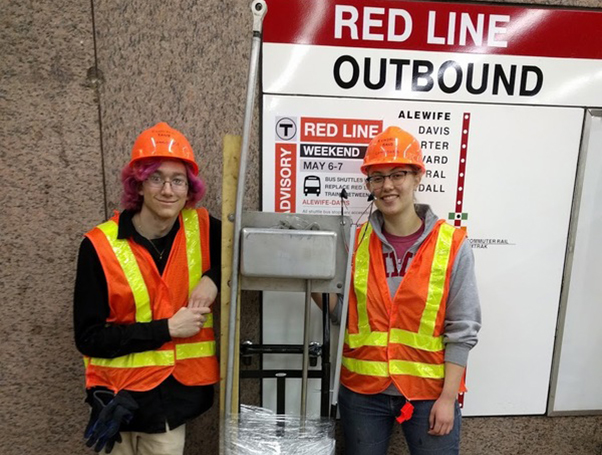MIT Concourse Team Restores Kendall T Station’s Musical Installation
-
-
slice.mit.edu
Filed Under
Recommended

The Kendall Band, a three-part musical sculpture in Kendall T Station, was first dedicated in October 1987. Each piece — Pythagoras, a line of alternating 16 bells and 14 hammers; Kepler, a 55-inch diameter ring and hammer; and Galileo, a stainless steel “thunder sheet” — can be played by someone standing on either platform of the station.
Paul Matisse, now 84, had spent years carefully crafting and tuning the three pieces. Matisse comes from an artistic lineage as grandson of Henri Matisse and stepson of Marcel Duchamp. He studied at the Harvard Graduate School of Design’s architecture program. In 1963, Matisse invented the Kalliroscope, an artwork visualising currents in liquid, which he still sells to museums and research centers. After 1980, Matisse switched to working primarily with sound, including many large bell installations.
Drasco and two of his students, Maxine “Max” Beeman ’20 and Carlos Sendao ’20 [above], fixed Pythagoras.
Unfortunately, the Kendall Band broke soon after its installation, with Pythagoras failing before Kepler and Galileo were even fully installed. Matisse said, in an email to The Tech, that he himself recognized “as a not very sophisticated piece of machinery, it does have a few weaknesses: connections loosen or break, parts occasionally fail.”
Matisse first worked on repairs alone. But, after nearly 20 years, Matisse began to tire of the work. He said, “I eventually realized that if its music mattered enough to the riders of the T, the repairs would have to come from a supporting group, ideally a small band of students from MIT.”
In June 2009, Brown University alumnus Seth Parker came to similar conclusions. He asked various organizations for support and ultimately found MIT Theater Arts’s Clarise Snyder. Snyder then contacted MIT technical instructor in Materials Science and Engineering Michael Tarkanian ’00. They formed the Kendall Band Preservation Society, a student team of over 20 members. The MBTA trained and permitted the team to restore the Kendall Band. After 13 months, the team restored Pythagoras and held a re-installation ceremony on Apr. 30, 2011.
Soon, though, the Kendall Band Preservation Society lost its status as an official MIT student group. Tarkanian said, “I just ran out of time and energy to devote the project, but it kept me up at night not working on it because the Kendall Band is a special thing to me. I wanted someone to work on it.”
Luckily, Tarkanian found Concourse physics instructor Steve Drasco. Drasco first experienced the Kendall Band in the early 1990s as a graduate student visiting from New York. In an interview with The Tech, he said he was fascinated by the installation’s mixture of art and science.
But, when Drasco returned in 2016 to begin his job at MIT, he found that the Kendall Band was no longer working. Drasco’s wife, an art historian at Harvard, connected Drasco to Matisse through a coworker. Matisse then brought Drasco to Tarkanian. Tarkanian called Drasco “a perfect fit.”
By May 2017, Drasco and two of his students, Maxine “Max” Beeman ’20 and Carlos Sendao ’20, had fixed one of the outbound levers on Pythagoras, which once again chimed in the station. This year, Drasco has enlisted several more students to work on the project.
So far, Drasco and his students have been down in the station to work on the project four times. Lani Lee ’21, one of the students who joined the project this year, said in an interview with The Tech that she originally joined because of her interest in music. She also said, “It’s a cool project because … we go [to Kendall Station] all the time and … it’s … very relaxing [to listen to].”
Read the complete Tech story to learn about the current challenges.








